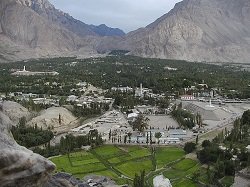By Wazir Aftab Hussain
Baltistan is nestled in the embrace of massive lofty snow-capped mountains in the Karakoram Mountain range. It has long been a paradise for adventure enthusiasts and nature lovers. Its breathtaking landscapes, and the world’s highest peaks, including K2, the second-highest mountain on Earth, glaciers, and rivers, make it a prime destination for mountaineers and trekkers. Baltistan plays a crucial role in Pakistan’s tourism industry and serves as a vital area for hydrological resources, impacting agriculture and water supply in the broader region.
Skardu, the capital of Baltistan, lies at its heart, surrounded by pristine and untouched viewpoints. The city is surrounded by numerous tourist spots. To the north lies the stunning Deosai plateau, while the mighty Indus River flows to the south, offering breathtaking views of the mountains and the unique Kharpocho Fort in the heart of the city. In the east are Kachura Lake and the famous Shangri-La Resort, while the west boasts the beautiful Shigar Valley. This strategic location makes the city a popular base for tourists, as it provides easy access to these attractions. With Air Blue, a private airline, operating its service to the city for the past two years, besides PIA, the national flag carrier, Skardu now receives more than four flights daily, each carrying a maximum number of passengers.
Traffic congestion
However, this accessibility has a downside for the residents. The recent surge in tourism — often referred to as “hyper-tourism” — has cast a shadow over this once-idyllic haven. The influx of vehicles has overwhelmed the city’s already fragile ecology and poor infrastructure, creating significant challenges for the local population.
The increased number of tourists has led to significant traffic congestion, a visible consequence of “hyper-tourism” in the region. The city’s narrow roads, already strained by local traffic, struggle to accommodate the influx of vehicles. Long lines of cars, tour buses, and motorbikes move at a snail’s pace, turning routine journeys into frustrating ordeals. Simple errands take so much time that many locals avoid going out during the daytime to save time and energy. The lack of regulation further exacerbates the problem. With minimal administrative presence, only a few traffic personnel can occasionally be seen moving about, unable to control the heavy traffic on the city’s narrow roads. Parking has become a chaotic free-for-all, with cars regularly blocking streets and driveways.

Noise and air pollution
The absence of enforced rules leads to a disorder where might make right.The frustration of locals is palpable. Their commutes are extended, businesses suffer, and the peaceful charm of the city is disrupted by noise and air pollution. The constant honking of horns has become a significant irritation.
Moreover, the delicate ecosystem of Skardu is suffering. The influx of traffic leads to dust pollution, impacting the health of residents. Those allergic to dust are often forced to stay indoors to avoid exacerbating their symptoms.Most of the roads in the city are already in a dilapidated condition, and the overload of vehicles is putting extra strain on the neglected infrastructure. This exacerbates the damage and creates a vicious cycle of maintenance woes. The deteriorating roads, unable to handle the increased traffic, worsen more rapidly, leading to frequent breakdowns and repairs that disrupt daily life even further.

Sustainable solutions
To ensure that tourism remains a blessing rather than a problem in the region, a multi-layered approach is needed to ameliorate the situation.
Strict, and indiscriminate enforcement of traffic rules is paramount. Officers should be empowered with proper training and authority to effectively manage traffic.
Recruiting traffic personnel from different regions could improve enforcement. Local sergeants often hesitate to penalize people they know, and some individuals with power and large vehicles ignore their directions, undermining traffic control efforts. By bringing in officers from outside the region, impartial enforcement can be better ensured, reducing the influence of local relationships and power dynamics.
No one should be allowed to drive without a proper and authorized license. Currently, many underage boys drive recklessly on the roads, contributing to chaos.
The designation of alternate routes/bypass expressways and timing for big vehicles is necessary, which can significantly reduce congestion.
The issue of parking can be sorted out by allocating specific places near the city as parking spots, and no tourists should be allowed to park their vehicles inside the city’s main roads.
Tourists should be briefed on entry points of the city (both by road and by air) about the fragility of the infrastructure and the ecosystem of the region, as well as the consequences they may face if they fail to follow the rules and regulations. Educating the tourist about responsible parking, respecting local customs, and minimizing their environmental footprint can play a big role in alleviating the problem.
Finally, closed-circuit (CCTV) cameras should be installed across the city to monitor traffic movement via a traffic control room. We are currently living in the age of technology, and not taking advantage of it will be our own mistake.
By employing these measures, we can strike a balance between reaping the economic benefits of tourism and protecting the city’s residents. Preserving the area’s natural beauty and pristine condition will continue to attract visitors and enrich their experiences. Otherwise, the danger of losing its charm looms large.

Wazir Aftab is a media student currently working as the Deputy Controller of Examinations at the University of Baltistan. He writes about social and policy issues. He completed his master’s in media and communication from Brunel University London.

The High Asia Herald is a member of High Asia Media Group — a window to High Asia and Central Asia

